
Monday, August 11, 2008
Wednesday, October 17, 2007
Wednesday, December 13, 2006
Drip Irrigation
 We decided to prepare an automated drip irrigation system.
We decided to prepare an automated drip irrigation system.
Prepare a patch I used cardboard to smother the grass and then built up a raised bed with straw, mulch, and manure.
The 13mm black poly pipe was laid out. I bought a 30 Meter, 4mm drip line from Bunnings that has drippers spaced every 30cm. Another method is to use 4mm pipe to attach to the poly pipe, and put in drippers wherever you want them. I've gone for simplicity this time around.
Above you can see I'm attaching the 4mm dripper line to the 13mm poly pipe. Use hole punches and connectors from hardware shops.
 We put in a few more lines and then it looked like this.
We put in a few more lines and then it looked like this.
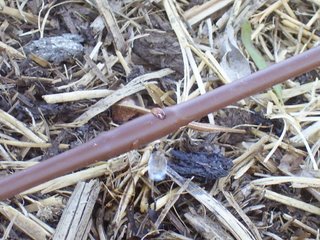 It works too. Dripping succesfully.
It works too. Dripping succesfully.

 A few weeks later it looks like this. From left to right. Zucchini, Onion, Watermelon, Spinach, Cucumber. Zekie is checking on the progress.
A few weeks later it looks like this. From left to right. Zucchini, Onion, Watermelon, Spinach, Cucumber. Zekie is checking on the progress.
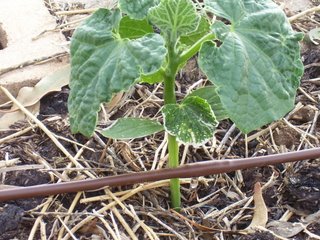

Close ups of Cucumber and Spinach. Water is dripping right onto the roots.

It worked so well we prepared another drip irrigation veggie patch. Planted out with Rockmelon, Onion, Tomatoes and Capsicum.
This time the drippers were put under the mulch. Should have done that last time. The drip line is all on an automatic watering system to go for a few minutes of drips at 8am and 8pm. Too easy!
Friday, November 03, 2006
Peak Oil - What is it all about?
Simply put, oil is a fossil fuel. We are extracting oil out of the ground at an incredibly fast rate. The 'peak' is when half of the oil is used. Out of the top 65 oil producing countries, 54 are past their peak and are now in decline.
As this graph shows we simply aren't finding enough oil to fill our insatiable demand.

Lots of articles, websites and lectures have been put together to make sense of it all.
Try this article on Richard Heinberg in the SMH; http://www.smh.com.au/news/national/when-oil-dries-up/2006/08/25/1156012745906.html?page=fullpage#contentSwap3
Richard's talks can be downloaded onto mp3. Well worth listening to. Try this one; http://www.globalpublicmedia.com/lectures/446
Watch the ABC TV Four Corners broadband edition on Peak Oil; http://abc.net.au/4corners/special_eds/20060710/
Or ABC's Catalyst program; http://www.abc.net.au/catalyst/stories/s1515141.htm
Visit ASPO (Australian Association for the study of Peak Oil and Gas); http://www.aspo-australia.org.au/
Sydney Peak Oil has a site; http://www.sydneypeakoil.com
And, go here too... http://www.eclipsenow.org/
Update
 Zekie watering the Broccoli. Celery is wrapped in newspaper on the left to make the stems longer as it grows upwards to catch the sun.
Zekie watering the Broccoli. Celery is wrapped in newspaper on the left to make the stems longer as it grows upwards to catch the sun. Parsnips which were the amongst the first things planted have been going great. It's really pleasing to see them come good. Can't wait to eat them.
Parsnips which were the amongst the first things planted have been going great. It's really pleasing to see them come good. Can't wait to eat them.
 Loads of tomatoe plants, maybe a 10 or so. There's more to plant after the seedlings grow some more. Hopefully we can preserve the extras somehow.
Loads of tomatoe plants, maybe a 10 or so. There's more to plant after the seedlings grow some more. Hopefully we can preserve the extras somehow.
On the left you can see the remains of the snap peas. They were hit hard by the frost and died after producing just a few peas.
 Loads of stuff here. Lot's of Lettuce - too much for us to eat. The Yellow Zuccini is fantastic! Lot's of Brussel Sprouts and well as Lemon Thyme and Chinese Cabbage.
Loads of stuff here. Lot's of Lettuce - too much for us to eat. The Yellow Zuccini is fantastic! Lot's of Brussel Sprouts and well as Lemon Thyme and Chinese Cabbage.Some seeds have been planted in the seed boxes on the right.

Currently trying to work out where to plant all these seedlings. We are running out of room in the front yard, and will have to extend into the back yard.
Heres a list of what we have planted;
Spinach (6 Fantastic plants. We keep eating, they keep producing)
Silverbeet (appx 6, have produced all the Silverbeet we've wanted & more)
Strawberries (appx 15)
Cabbage (hit hard by bugs though. We need to learn more about organic pest control)
Cauliflower (also hit hard by bugs)
Red Onion
Celery
Spring Onion
Brussel Sprouts
Squash - Yellow
Squash - Green Buttons
Zucchini - Yellow
Chinese Cabbage
Cos Lettuce (Powering along. Too much for us and we've been able to give away a few lettuce plants)
Pumpkin - Golden Nugget
Chilli - Red Cayenne Hot
Eggplant
Rhubarb
Parnsip
Tomato -1st Prize
Tomato - Apollo
Tomato - Tiny Tom
Celeraic
Passionfruit
Capsicum
Jalepeno Peppers
And also some herbs;
Basil
Chives
Mint
Lemon Thyme
Thyme
Marjoram
Peppermint
And many varieties of seeds have just been planted in seedling containers.
All of the above has been planted in a very small area that borders the front garden.
Sunday, October 08, 2006
Laundry Grey Water

Cutting a hole in the door for the laundry grey water pipe
 Through the door and into a hole cut into the balcony
Through the door and into a hole cut into the balcony A gentle slope under the balcony. The pipe is just held up by string
A gentle slope under the balcony. The pipe is just held up by string There are a few laundry grey water 'systems' available at hardware stores, but they are just wide 10 metre pipe with a nozzle for the laundry hose outlet (cost $20-$25). I couldn't find a simple connection anywhere for the grey water pipe to connect to standard 19mm poly pipe to run the water to the fruit trees. The above connection took the guy in the hardware store about half an hour to figure out. There's quite a few bits and pieces used for something that should be quite straightforward. You wouldn't think that there's a drought on.
There are a few laundry grey water 'systems' available at hardware stores, but they are just wide 10 metre pipe with a nozzle for the laundry hose outlet (cost $20-$25). I couldn't find a simple connection anywhere for the grey water pipe to connect to standard 19mm poly pipe to run the water to the fruit trees. The above connection took the guy in the hardware store about half an hour to figure out. There's quite a few bits and pieces used for something that should be quite straightforward. You wouldn't think that there's a drought on.
Anyway, it works!
 It's a temporary measure, but it works fine.
It's a temporary measure, but it works fine.
 And onto the fruit trees.
And onto the fruit trees.
I'll do some more work on it later to devise a system where we just use a series of taps to divert the water onto different groups of trees.
A couple of things to keep in mind if you plan on doing something similar. Don't do any hot water washes if it will run onto the trees. Regular laundry detergent has too much salt and other stuff. There are a few safer alternatives available. Check this website out for research on laundry powders... http://www.lanfaxlabs.com.au/laundry.htm
Monday, September 11, 2006
Fruit Trees
We were also put off by most books/webpages which suggest giving the trees plenty of room to grow. A fine suggestion if you have plenty of room, but we dont.
Others suggest that trees could be 'espaliered' (grown along a fence) and which takes up less room but produce more fruit for the area. There are also various pruning techniques which are designed to keep the trees small and productive. We've decided to plant apricots, nectarines, peaches, plums and pears close together and keep them small. There is also a cumquat tree, and a couple of 'dwarf' peach trees.
The apple trees will be espaliered along a fence since they are apparently most suitable for that technique. Apparently there's a bit more time to safely plant the apple trees, and we will be doing those in the next couple of weeks. We've pretty much run out of room for citrus trees like oranges and mandarins, but I'm sure we can squeeze them in somewhere.
It has cost a bit, but not as much as might be expected. The fruit trees have been between $20-$25 each, except for the 'dwarf' peach trees which were $45 each.
The fruit tree list so far;
Apricot (2)
Nectarine (2)
Plum (2)
Peach (3, 1 regular and 2 dwarf)
Pear (2)
Cumquat (1)
Apple (5)

As you can see the ground here is virtually 100% sand. We might as well be growing in a desert. Loads of potting mix was added to the holes dug up for the fruit trees.

Dwarf peach trees. These were potted.

Meika and Jason planting a couple of apricot trees. The ground is this section is incredibly rocky. Hopefully these trees still grow OK.
 Cross-pollinating plum trees
Cross-pollinating plum trees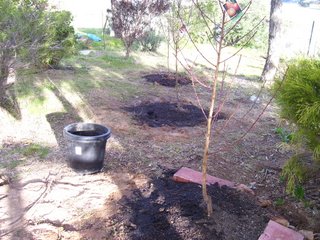
A peach tree in the foreground and cross-pollinating nectarines in the background.
Tuesday, August 29, 2006
Update
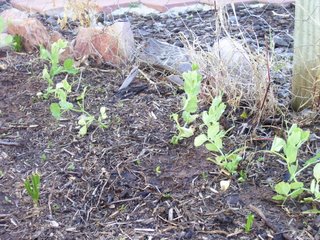
The snow peas have been hit by the frost, but most look like surviving.
 The mass of green is cress. Growing fantastically well. The mustard is popping up.
The mass of green is cress. Growing fantastically well. The mustard is popping up. Even though we've been eating the spinach and silverbeet leaves every 2nd day or so, more just keep appearing like magic.
Even though we've been eating the spinach and silverbeet leaves every 2nd day or so, more just keep appearing like magic.
Karena, Meika and Zekie enjoying the frontyard. The brocolli is powering along.
Thursday, August 24, 2006
Update


There's a lot to update, and a proper post will follow in a few days. We've been very sick over the past week, and a bit distracted as the Cowra Blues AFL team just made it into the grand final to be played on 2nd September. But for now, a brief summary;
We've been eating loads of home grown spinach, silverbeet, cress, mustard and some celeraic leaves. The broccoli is coming along very well, and lots of other plants are growing well too.
We need help though. We've contacted a friend's dad who once featured on ABC TV's 'Gardening Australia' and we are hoping he can help us plan out the fruit trees ( a very difficult process in a small area), and another friend's dad who is a chicken expert! The challenge is to build an integrated chicken run that can serve multiple functions, such as espalier trelliss for fruit trees. It has to be cheap too.
More vegie garden beds need making as well, and a couple are ready for planting.
Some of the seedlings are growing well too, and some failed completely.
There's a picture above of our house taken from a train. We recently went on a short trip (20 mins each way) with Wendy and Angela from Sydney.
Another blog will be set up soon with family pics.
Wednesday, August 09, 2006
Composting
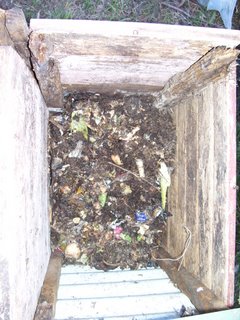


A really pleasing part of this project is re-using kitchen 'waste'. It is amazing how much food we throw away. Not any more though. A bin is in the kitchen for food scraps, which gets taken out to the compost bin every couple of days or so. Lot's of coffee in this bin!
The outdoors compost bin was left by the previous owners. It's not the greatest bin in the world. It is falling apart, and it's hard to turn the compost over in. Nonetheless, it's a good start. We've just borrowed a book on composting from the library so we should be able to work something out for the longer term
You can see the plants that have sprung up next to the outdoors compost bin, thriving on the extra nutrients.



